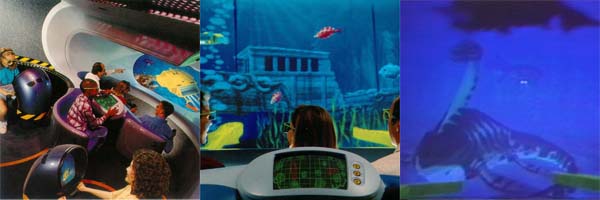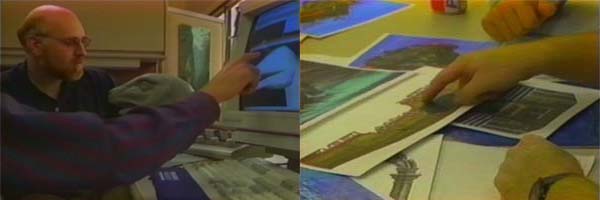
In Virtual Adventures, four teams of six competed to rescue the Loch Ness Monsters eggs.
Virtual Adventures: The Loch Ness Expedition was a 24-player game consisting of four networked pods holding six players each. Players took the roles of “volunteer scientists” sent into the Loch Ness in a submersible to rescue Nessie’s eggs from “bounty hunters” (actually other players who all see themselves as rescuers.) Each player had a unique input device designed to compliment the controls of others, to promote player interdependency. Based on my prior research, this format had great cross-gender as well as intergenerational appeal because it combined both competition and cooperation. I was brought in to Creative Direct the project, which included designing the game and writing game design documents, overseeing design of the pod, input devices, computer graphics art direction, writing the script for video tutorials, and overseeing integration of all the elements.

Evans & Sutherland’s crack team of graphic artists sculpted Nessie’s head and hand-painted all the textures to give the game its highly crafted look and feel.
Created by Iwerks Entertainment (now a subsidiary of SimEx) with Evans & Sutherland, the originators of “virtual reality,” using one of their high-end flight simulators, Virtual Adventures was considered a landmark because it was the first attraction that combined virtual reality simulation, game design, and narrative with high production value. (Shortly thereafter, Disney came out with its DisneyQuest high-tech attraction centers, which also explored this territory.) I’m happy to be corrected on this, but to my knowledge (and I am happy to be corrected on this), the largest number of people who had been networked together in a VR entertainment application up to that point. (The BattleTech Centers, an earlier LBE chain, only had sixteen.)
The game revolved around the discovery of the Loch Ness Monster and her eggs. The design of the monster is based on some research I discovered supporting the theory that the Loch Ness Monster is an ancient elasmosaur.
The game was introduced at the IAAPA Theme Park Expo in 1993 where it won Best of Show, and was in the SIGGRAPH Electronic Theater in 1994. It won eight awards including the first “Best Virtual Reality” award from the Academy of Interactive Arts & Sciences. The last unit continued to operate at Nauticus in Norfolk, Virginia, until a couple of years ago. I occasionally have a student who visited it as a kid. (For more information on this project, see The Interactive Book.) I served as Creative Director on the project under Eddie Newquist, who was then VP of Production.
For more on Virtual Adventures see:
Brell, L.M. (1994?) Getting Into the Act: When Audiences Star In Their Own Shows. Fun World. (I’m not sure what issue this was in.)
Ginsberg, S. (1993). Interactive tech companies target amusement parks. Los Angeles Business Journal, November 29, 1993
Pearce, C. (1995). “The Ins and Outs of Nonlinear Storytelling.” ACM Computer Graphics, Volume 28, Number 2, May 1994.
Pearce, C. (1997). The Interactive Book: A Guide to the Interactive Revolution. Indianapolis: Macmillan.